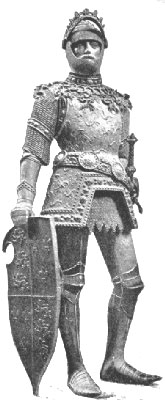King Arthur
King Arthur was a mythical king in the mythology of Great Britain. He lived in the medieval times, in his famous castle, Camelot. He possessed a sword known as Excalibur, given to him by the Lady of the Lake.

King Arthur is a fabled ruler of Sub-Roman Britain who defended his kingdom from the Anglo-Saxons. He is a popular fictional character in modern literature. He won several battles, and had many homes. However, his favorite home was in Camelot. In one of the most famous tales of King Arthur, he pulls a sword out of a stone, making him King of the Britons.


The first narrative account of Arthur's life is found in Geoffrey of Monmouth's Latin work Historia Regum Britanniae (History of the Kings of Britain), completed c. 1138.[1][2]
Camelot change
Many castles claim to be Arthur's Camelot, but the most likely one is Tintagel Castle, Cornwall (though there is no evidence for this[3]). In Camelot sat the famous Round Table, where Arthur, his queen Guinevere, Merlin, Morgan le Fay, Sir Lancelot, Sir Gawain, Percival and many other valiant knights sat. Arthur and his knights went on many quests including The Quest For The Holy Grail, The Green Knight, The Black Knight and more.
Death change
After King Arthur's many adventures, his son Mordred seized his kingdom and queen, forcing Arthur to fight for what was truly his. They fought for a long time. Mordred hit King Arthur in many places, but in the end Arthur killed Mordred. After this victory, King Arthur was weak and died of blood loss from battle wounds. As his knights rode back to Camelot, they threw Excalibur into the lake so that it could return to where it came from.[4] One legend says Arthur never died, and will return when the British need him.
Books, poems and movies change
Many books have been written about King Arthur. Most of them involve Merlin, the Knights of the Round Table, and Morgan le Fay.
Geoffrey of Monmouth wrote the first book about Arthur in the 12th century. In the 15th century, Sir Thomas Malory wrote one of the best-known books about Arthur, called Le Morte d’Arthur (The Death of Arthur). Later, in the 19th century, Alfred, Lord Tennyson visited Tintagel, the mythical Camelot, twice. He wrote a series of poems about Arthur.
Some stories about Arthur say he tried to find the Holy Grail, the cup that Jesus drank from at the Last Supper.[5]
There are also many movies about Arthur. These include Disney's The Sword in the Stone; Monty Python and the Holy Grail; King Arthur (2004); King Arthur, The Kid Who Would Be King (2019); the Legend of the Sword (2017); and the musical Camelot.
References change
- ↑ Thorpe, Lewis, ed. 1966. Geoffrey of Monmouth, The History of the Kings of Britain. Harmondsworth: Penguin.
- ↑ Loomis, Roger Sherman 1956. The Arthurian legend before 1139. In Loomis, Roger Sherman Wales and the Arthurian legend. Cardiff: University of Wales Press, pp. 179–220,
- ↑ Thomas, Charles 1993. Tintagel: Arthur and archaeology. London: Batsford/English Heritage. ISBN 978-0-7134-6690-4
- ↑ "King Arthur." World History: Ancient and Medieval Eras. ABC-CLIO, 2013. Web. 27 Feb. 2013.
- ↑ Reiss, Edmund. "Arthur, King." World Book Student. World Book, 2013. Web. 27 Feb. 2013.